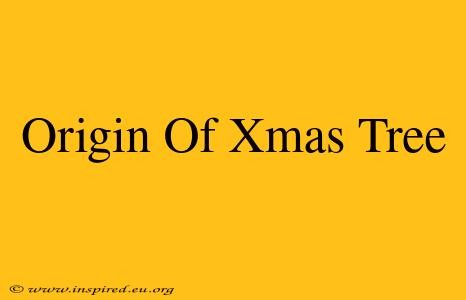The Christmas tree, a symbol synonymous with the holiday season, boasts a rich and fascinating history. Its evolution from ancient pagan traditions to the iconic centerpiece of modern Christmas celebrations is a journey through time and cultural shifts. Understanding its origins provides a deeper appreciation for this beloved holiday symbol.
Early Influences: Pagan Winter Solstice Celebrations
The origins of the Christmas tree aren't solely Christian. Long before the birth of Christ, various cultures celebrated the winter solstice with evergreen trees, symbolizing life's persistence through the dark winter months. These trees often played a role in pagan rituals and celebrations.
The Role of Evergreens in Ancient Cultures
Ancient Egyptians used palm branches to decorate their homes during winter festivals. Similarly, Romans used evergreens to adorn their temples during Saturnalia, a week-long festival honoring the god Saturn. These traditions demonstrate a deep-rooted connection between evergreens and winter celebrations, predating Christianity by centuries.
The Transition to Christian Symbolism
The transition of the evergreen tree into a specifically Christian symbol was a gradual process. While the exact timeline is debated, several key moments contributed to its association with Christmas.
Paradise Trees in Medieval Germany
During the Middle Ages, "Paradise trees" became popular in Germany. These were decorated trees used in Christmas plays and were often associated with the Tree of Knowledge from the Garden of Eden. These early Paradise trees are considered direct ancestors of the modern Christmas tree.
Martin Luther and the First Illuminated Tree?
Legend attributes the first illuminated Christmas tree to Martin Luther, the Protestant reformer. The story goes that he was inspired by the sight of stars twinkling through the branches of an evergreen tree on a snowy night. Whether or not this story is true, it helped solidify the tree's place in Christian tradition.
The Christmas Tree's Rise to Global Popularity
The 19th century witnessed the Christmas tree's explosive growth in popularity, spreading from Germany across Europe and eventually to the rest of the world. This widespread adoption was driven by several factors.
The Influence of Royal Families
Royal families, particularly in England, embraced the Christmas tree, furthering its association with prestige and celebration. Queen Victoria's Christmas tree, depicted in popular prints, significantly boosted its popularity across the British Empire.
The Rise of Victorian Christmas Traditions
The Victorian era's emphasis on domesticity and family celebrations perfectly aligned with the Christmas tree's symbolism of warmth and togetherness. This contributed greatly to its widespread adoption within Victorian homes.
Mass Production and Accessibility
Advances in technology and mass production made Christmas trees more accessible and affordable to a wider population, further fueling their popularity. The standardization of artificial trees further cemented its presence in the modern Christmas celebration.
The Modern Christmas Tree: A Global Symbol
Today, the Christmas tree stands as a universally recognized symbol of Christmas, transcending cultural and religious boundaries. Its enduring appeal lies in its ability to evoke feelings of warmth, joy, and togetherness.
Variations in Decoration and Traditions
While the basic concept of a decorated evergreen remains consistent, variations in decoration and traditions exist around the world. From simple ornaments to elaborate displays, the Christmas tree continues to adapt and evolve, reflecting the diverse cultures that celebrate it.
The Enduring Symbolism of Hope and Renewal
At its core, the Christmas tree retains its ancient symbolism of hope and renewal. Its evergreen foliage represents the promise of life enduring through the darkest of times, a message that resonates deeply with people worldwide during the winter solstice and Christmas season.
This exploration into the origin of the Christmas tree reveals its rich and complex history, blending pagan traditions, Christian symbolism, and modern cultural influences. Its evolution reflects a fascinating interplay of beliefs, practices, and societal shifts across centuries. The Christmas tree continues to stand as a powerful and enduring symbol of the holiday season.
